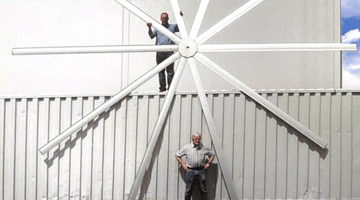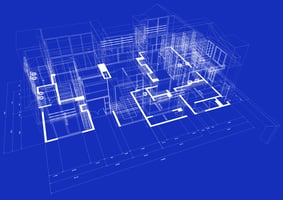The pioneering spirit of MacroAir's founder, Walter Boyd, and his son, Eddie Boyd, is evident in...
Ceiling Fan Maintenance - Top Tips From The Pros
High Volume Low Speed (HVLS) fans are a great solution to improve energy efficiency and indoor air quality, and the technology has surged in popularity in indoor and outdoor spaces across the country. Although HVLS fans result in reduced maintenance and repair costs compared to traditional HVAC systems, proper ceiling fan maintenance is important for facility maintenance managers to know and perform in order to keep their HVLS fans in the best condition for optimal performance.
When routine maintenance is not performed on your HLVS fan, layers of dust will accumulate over time, adding weight to the fan blades. This puts them at risk of becoming unbalanced during operation. Unbalanced fans affect performance and can put your fan at risk of blade failure.
Will Butler, MacroAir’s Field Service Manager, is an expert when it comes to HVLS fan maintenance and installation. He knows HVLS fans inside and out. Butler says, “I have been in multiple situations where the preventive maintenance was not performed, and the blades are a nightmare to clean as well as gross.”
Butler also tells us it is important to perform routine maintenance in all types of environments. But he says it is especially important in gym, restaurant, warehouse, and automotive environments. These environments are prone to collect a ton of dirt, grime, grease, and dust that is terrible to breathe in. When grease and grime build up, dirt sticks, and it piles up quickly.
We recommend performing the following ceiling fan maintenance procedures annually.
Before beginning any routine maintenance procedures, make sure you turn the HVLS fan’s power off. Refer to your warranty to find out what it covers, in terms of repairs and replacement parts, should any problems arise.
Annual Ceiling Fan Maintenance Checklist
 1-Initial Overall Check
1-Initial Overall Check
Look for any missing parts, cracks on blades and frame, or other signs of damage on the HVLS fans to avoid any injuries.
 2-Mounting Hardware Check
2-Mounting Hardware Check
Check all mounting bolts to be sure they have not loosened. Tighten any bolts that are loose.
 3-Guy Wire Check
3-Guy Wire Check
Checking an HVLS fan’s guy wires for tension and inspecting for frayed sections could mitigate a problem before it occurs. Properly installed guy wires will keep the fan stable in case of an earthquake or installations where high wind conditions may occur.
The guy wire should be tight at all times. If they have been shocked and loosened, they may need to be tightened. Loose guy wires are more likely to break than tight guy wires. Additionally, you should confirm that the guy wires are not wrapped around any sharp edges. MacroAir recommends attaching guy wires to the building with eye bolts or eye lags in order to help keep the guy wires from fraying.
If guy wires are installed with turnbuckles, jam nuts should be checked to ensure tightness.
 4-Power unit
4-Power unit
The power unit, or motor housing, should have proper lubricant for life as they are sealed. However, still, check to see that there are no lubrication leaks. To confirm nothing is leaking, remove the bottom cover of the fan and check for any signs of oil in the cover or around the Fenner Bushing. Also, check the unit to confirm nothing has vibrated loose.
 5-Safety cable check
5-Safety cable check
HVLS fans should come with a safety cable. The safety cable will prevent the fan from falling in the unlikely event the mounting system should fail.
Depending on the fan model and installation method, the safety cable either wraps around the building structure and the fan frame or comes out of the top of the fan and wraps around the building structure. The safety cable is an important part of the safety system and acts as a last resort should an earthquake, collision or similar catastrophic event occur. As such, it’s vital for you to ensure that it is intact and properly secured.
Cleaning Your HVLS Fan
Ceiling Fan Blades
Depending on the type of commercial application your HVLS fan is in, there can be quite a bit of dust or other particulates, including grease, clinging to the ceiling fan blades. While this may not affect fan performance right away, we recommend you keep the blades clean by wiping away any excess dust on the fan blades with a rag or vacuum cleaner every 3-6 months. Interestingly enough, Butler, MacroAir’s Field Service Manager, has found that powder-coated fan blades are easiest to clean, as they tend to collect less dust than standard blades with no powder coating.
Once fan blades are vacuumed or wiped, use hot soapy water or regular cleaning solutions with a damp cloth or sponge to wipe the blades clean. Please do not use chlorine or any chemicals containing chlorine. Butler recommends ZEP Fast 505 Cleaner & Degreaser and Simple Green. He says both products work very well for this process.
Ceiling Fan Control Panel
In a dusty and dirty environment, a can of compressed air works well to clean the inside of the panel. Then, simply wipe down the outside of the enclosure with a cloth or duster. Should any problems arise, refer to your warranty to find out what it covers, in terms of repairs and replacement parts.
MacroAir Ceiling Fan Care Card
Download your free MacroAir Fan Care Card. This is a quick reference card for all annual fan maintenance.
Find the Right HVLS Fan For Your Facility
If you don’t have an HVLS fan in your facility and your facility manager is considering adding one, here are additional things to consider when comparing HVLS fans and manufacturers to ensure you’re getting the best performance for your application and need:
1-Performance
Take a good look at your facility space and existing HVAC systems to see which HVLS fan best meets your needs. Can you take advantage of natural ventilation or do you need to supplement a forced-air system?
2-Installation
Building parameters, support beams or structures, clearance requirements, and built-in control features will all affect installation and, ultimately, the fan’s performance. To maintain continuous air exchange, MacroAir recommends installing one HVLS fan per 20,000 square feet of space.
3-Customer Service and Warranties
The HVLS fan manufacturer you select should be just as available as the representative group selling you the fan and should help you have a good understanding of the warranty coverage. Furthermore, companies with confidence in their product generally have strong mechanical and electrical warranties in place. Check through the specifications of the warranty to know what is covered in terms of repairs and replacement parts.
Bottom Line
Safeguard your HVLS ceiling fan investment by following these regular maintenance practices. This crucial upkeep ensures your HVLS fans remain in prime condition, facilitating optimal performance. Begin with a straightforward and simple step – acquiring the necessary equipment. Click the link provided to find the ideal cleaning brush tailored to industrial fan maintenance.
Eddie Boyd is president of MacroAir, which manufactures energy-efficient, long-lasting HVLS fans that can be found in warehouses, manufacturing plants, airplane hangars, agricultural arenas, and retail establishments across the U.S. and around the world.
The original article was published in Cleaning & Maintenance Management and written by MacroAir CEO, Eddie Boyd. Revisions and updates have been applied to the original article to reflect the changes and updates in the product line.
Boyd, E. (2013, August). Maintaining and Cleaning High Volume, Low Speed Fans. Cleaning & Maintenance Management, 38–39.

